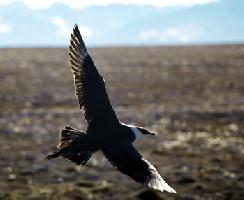
Popis zvířete
The South Polar Skua, scientifically named Stercorarius maccormicki, is a large, robust seabird that commands attention with its powerful presence in the harsh environments it calls home. This species belongs to the family Stercorariidae, which encompasses the skuas, and it is particularly well-adapted to thrive in the extreme conditions of the Antarctic and the surrounding oceans.Measuring between 53 to 58 centimeters in length and boasting a wingspan of 125 to 140 centimeters, the South Polar Skua is a bird of considerable size. Its plumage varies from light to dark morphs, offering an intriguing variety within the species. Generally, the bird displays a brownish or dark plumage, which effectively camouflages it against the rocky Antarctic landscape and the open seas. The lighter morphs have a more mottled appearance, with a blend of brown and white feathers that provide camouflage in the snowy environments.
One of the most distinctive features of the South Polar Skua is its powerful, hooked beak, which is perfectly designed for its carnivorous diet. This bird is an opportunistic feeder, preying on a wide range of foods. Its diet includes fish, which it often steals from other seabirds in a behavior known as kleptoparasitism, as well as other birds' eggs and chicks. Remarkably, it is also known to hunt other seabirds, such as penguins, showcasing its prowess as a top predator in its ecosystem.
Breeding takes place in the austral summer, when the South Polar Skua returns to the Antarctic coastlines and islands to establish nesting sites. Unlike many seabirds that nest in colonies, the South Polar Skua tends to nest solitarily or in loosely aggregated groups. Nests are simple scrapes on the ground, often lined with stones, vegetation, or feathers. Typically, a clutch consists of one to two eggs, which both parents fervently defend against any potential predators, including humans who venture too close.
The South Polar Skua is a long-distance migrant, undertaking an impressive journey from its breeding grounds in the Antarctic to the northern hemisphere during the austral winter. This migration takes them across vast stretches of ocean, sometimes reaching as far north as the Arctic Circle, demonstrating their remarkable endurance and navigational abilities.
Despite the harshness of its environment and the challenges it faces, the South Polar Skua is currently not considered to be at significant risk. It is classified as Least Concern by the International Union for Conservation of Nature (IUCN), thanks to its wide distribution and sizable population. However, like many species, it may face threats from climate change and human activities in the future.
In summary, the South Polar Skua is a formidable and adaptable bird, well-suited to life in some of the planet's most extreme conditions. Its ability to thrive in the Antarctic and navigate vast distances across the world's oceans speaks to the remarkable resilience
Podobná zvířata
Nové fotografie zvířat
Top 10 zvířat
- Dolphin gull (Leucophaeus scoresbii)
- Diana monkey (Cercopithecus diana)
- Stone loach (Barbatula barbatula)
- Greek tortoise (Testudo graeca)
- Japanese macaque (Macaca fuscata)
- Moustached guenon (Cercopithecus cephus)
- Galápagos tortoise (Geochelone nigra complex)
- Russian tortoise (Testudo horsfieldii)
- Galápagos penguin (Spheniscus mendiculus)
- Common flying dragon (Draco volans)


